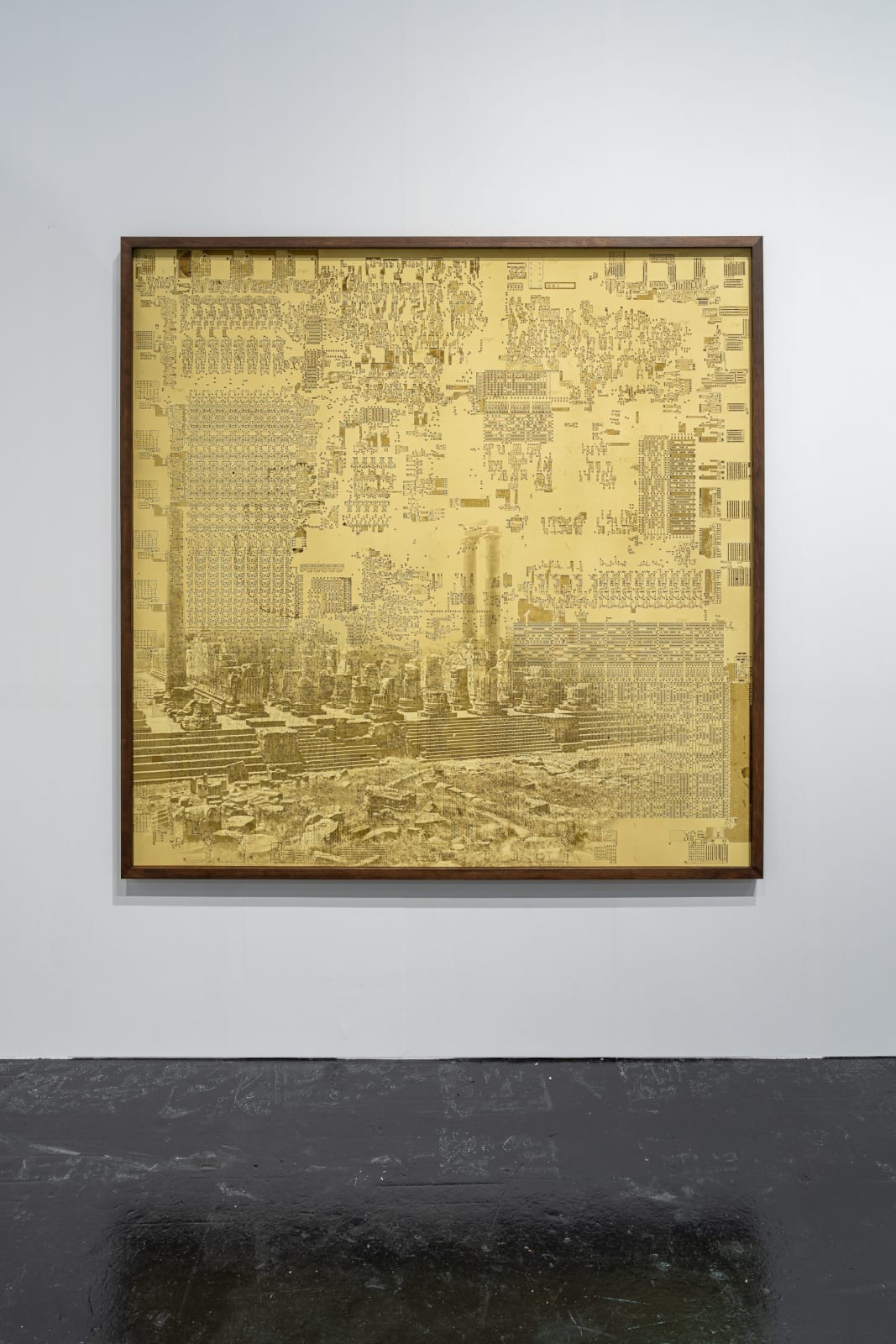Nicolás Lamas
The circulation of our ruins, 2023
Archival pigment print on Hahnemühle paper
164 x 164 x 4.7 cm
64 5/8 x 64 5/8 x 1 7/8 inches
64 5/8 x 64 5/8 x 1 7/8 inches
Ed. 1/1 + 1 AP
Copyright the artist and Meessen De Clercq
Photo: Dirk Tacke
Further images
In den Wandarbeiten „The circulation of our ruins“ (2023) und „Linguistic networks“ (2023) verbindet Nicolas Lamas historische Fotografien mit Abbildern von technischen Schaltkreisen und thematisiert damit die Entwicklung menschlicher Zivilisation....
In den Wandarbeiten „The circulation of our ruins“ (2023) und „Linguistic networks“ (2023) verbindet Nicolas Lamas historische Fotografien mit Abbildern von technischen Schaltkreisen und thematisiert damit die Entwicklung menschlicher Zivilisation. In seinen Werken findet ein ständiger Dialog zwischen gegensätzlichen Kräften statt, die ein hybrides Werk hervorbringen, das nicht in eine einzige Richtung definiert oder ausgerichtet werden kann. Lamas versucht in seinen Werken starre Konzepte linearen Fortschritts aufzubrechen und bringt Kunst, Wissenschaft, Technologie und Alltagskultur zusammen, indem er aus einem Fundus an gesammelten Bildern und Gegenständen schöpft. So bilden die collagierten Werke eine neue Sichtweise auf ihre ursprünglichen Kontexte und bieten die Möglichkeit immer neue Schlüsse aus dem Vergangenen zu ziehen, was die Grundlage für die Vorstellung einer möglichen Zukunft bildet.
In „The circulation of our ruins“ (2023) überlagert das Bild eines vergrößerten Schaltkreises eines veralteten Computermikrochips eine Fotografie der antiken Ruinen von Pergamon, einst Heimat der zweitgrößten Bibliothek der Antike. So verbindet Lamas zwei Epochen der Wissensbewahrung: das steinerne Archiv Pergamons und die modernen, auf Silizium basierenden Mikroprozessoren. Beide Strukturen tragen zur Bildung des kollektiven Gedächtnisses ihrer Gesellschaften bei und verdeutlichen das menschliche Verlangen, Wissen zu bewahren und weiterzugeben.
In the wall works "The circulation of our ruins" (2023) and "Linguistic networks" (2023), Nicolas Lamas combines historical photographs with images of technical circuits, thereby addressing the development of human civilization. His works embody a constant dialogue between opposing forces, resulting in a hybrid creation that cannot be defined or oriented in a single direction. In his pieces, Lamas aims to break away from rigid concepts of linear progress and brings together art, science, technology, and everyday culture by drawing from a collection of images and objects. In this way, the collaged works offer a new perspective on their original contexts and provide opportunities to draw new conclusions from the past, forming the basis for envisioning a possible future.
In "The circulation of our ruins" (2023), the image of an enlarged circuit from an obsolete computer microchip overlays a photograph of the ancient ruins of Pergamon, once home to the second-largest library of antiquity. In this way, Lamas connects two eras of knowledge preservation: the stone archive of Pergamon and modern, silicon-based microprocessors. Both structures contribute to the formation of the collective memory of their societies, highlighting humanity's desire to preserve and pass on knowledge.
In „The circulation of our ruins“ (2023) überlagert das Bild eines vergrößerten Schaltkreises eines veralteten Computermikrochips eine Fotografie der antiken Ruinen von Pergamon, einst Heimat der zweitgrößten Bibliothek der Antike. So verbindet Lamas zwei Epochen der Wissensbewahrung: das steinerne Archiv Pergamons und die modernen, auf Silizium basierenden Mikroprozessoren. Beide Strukturen tragen zur Bildung des kollektiven Gedächtnisses ihrer Gesellschaften bei und verdeutlichen das menschliche Verlangen, Wissen zu bewahren und weiterzugeben.
In the wall works "The circulation of our ruins" (2023) and "Linguistic networks" (2023), Nicolas Lamas combines historical photographs with images of technical circuits, thereby addressing the development of human civilization. His works embody a constant dialogue between opposing forces, resulting in a hybrid creation that cannot be defined or oriented in a single direction. In his pieces, Lamas aims to break away from rigid concepts of linear progress and brings together art, science, technology, and everyday culture by drawing from a collection of images and objects. In this way, the collaged works offer a new perspective on their original contexts and provide opportunities to draw new conclusions from the past, forming the basis for envisioning a possible future.
In "The circulation of our ruins" (2023), the image of an enlarged circuit from an obsolete computer microchip overlays a photograph of the ancient ruins of Pergamon, once home to the second-largest library of antiquity. In this way, Lamas connects two eras of knowledge preservation: the stone archive of Pergamon and modern, silicon-based microprocessors. Both structures contribute to the formation of the collective memory of their societies, highlighting humanity's desire to preserve and pass on knowledge.













